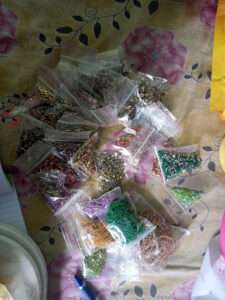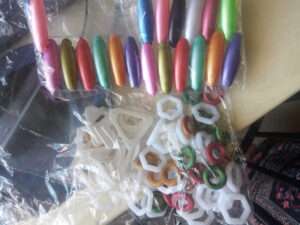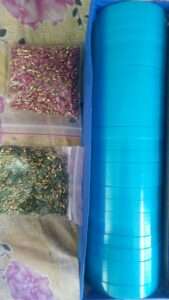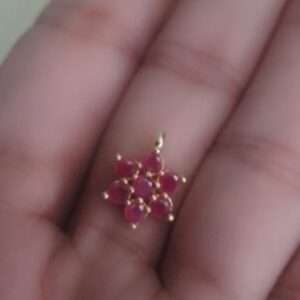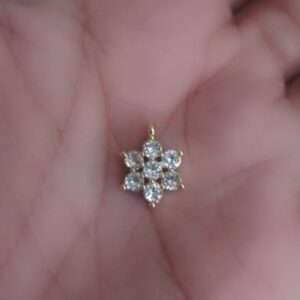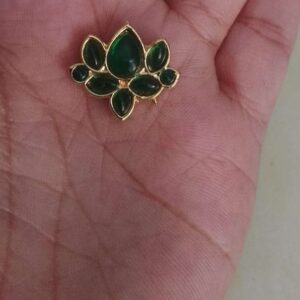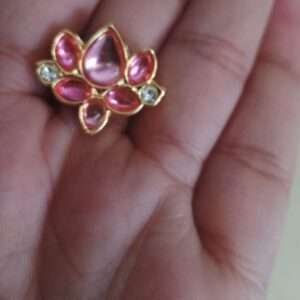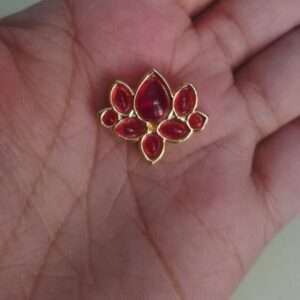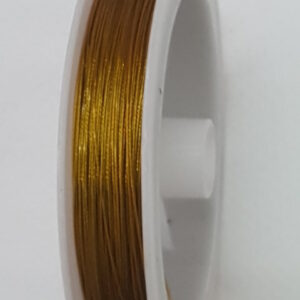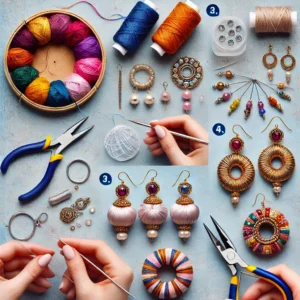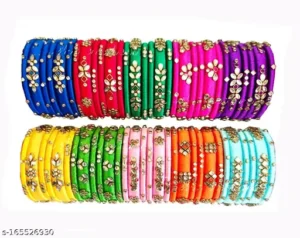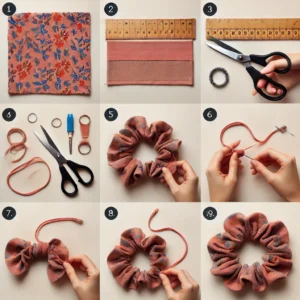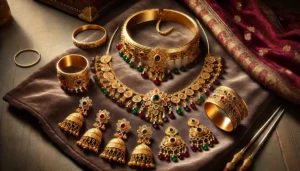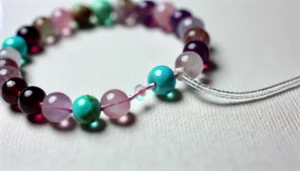Home » My blogs (Page 3)
Category Archives: My blogs
Creating a Maggam Hip Belt
Maggam work, also known as aari work or zardosi embroidery, is a traditional Indian embroidery technique that involves intricate thread work, beads, and sequins. Maggam hip belts are popular accessories that add a touch of elegance to traditional Indian outfits. If you’re interested in making your own Maggam hip belt, follow these step-by-step instructions:
Materials you will need:
- Wide fabric strip or velvet ribbon for the base
- Embroidery threads in various colors
- Needle
- Zardosi or aari needle (special needle for Maggam work)
- Beads, sequins, and embellishments
- Fabric glue or adhesive
- Scissors
- Measuring tape
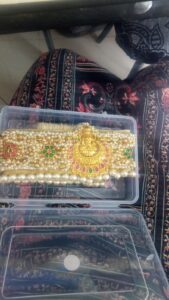
Step 1: Measure and cut the base strip Using a measuring tape, determine the desired length of your hip belt. Cut a wide fabric strip or velvet ribbon according to this measurement. The width of the strip can vary based on personal preference, but a width of 2-3 inches works well for a hip belt.
Step 2: Design the pattern Plan your design on paper or sketch it directly on the fabric strip. Choose motifs, floral patterns, or any design of your choice. Keep in mind the placement and spacing of the motifs along the length of the belt.
Step 3: Start embroidering Thread the regular needle with embroidery thread and secure a knot at one end. Begin embroidering the design by following your pattern. Use various stitches like chain stitch, satin stitch, or backstitch to create the desired motifs. You can incorporate different colors to make the design vibrant and eye-catching.
Step 4: Add embellishments Once the embroidery is complete, enhance the design by adding beads, sequins, or other embellishments. Use the zardosi or aari needle to attach these embellishments securely. You can experiment with different arrangements and combinations to achieve the desired look.
Step 5: Finishing touches Inspect your hip belt for any loose threads or uneven stitches. Make any necessary adjustments and trim excess threads with scissors. Ensure that all the embellishments are firmly attached.
Step 6: Attach the closure To fasten the hip belt around your waist, attach a hook-and-eye closure or a Velcro strip to the ends of the fabric strip. This will allow for easy wear and removal.
Step 7: Optional: Backing If desired, you can add a fabric backing to the inside of the hip belt for a neat finish. Cut a fabric strip slightly smaller than the width of the belt and attach it using fabric glue or adhesive. This will help conceal the embroidery threads and stitches.
Your Maggam hip belt is now ready to be worn with your favorite traditional outfit. Showcase your creativity and style with this unique accessory that adds a touch of glamour and elegance. Remember to handle the hip belt with care, avoiding rough handling or exposure to moisture to maintain its beauty and longevity.
How to Clean German Silver Jewellery at Home?
German silver jewellery, also known as nickel silver or alpaca silver, is a popular choice for its beautiful silver-like appearance. Over time, this type of jewellery can become tarnished or lose its shine due to exposure to air, moisture, and body oils. Cleaning your German silver jewellery regularly will help restore its original beauty. Here’s a step-by-step guide on how to clean German silver jewellery at home:
Materials you will need:
- Mild dish soap or jewellery cleaner
- Soft-bristled toothbrush or a clean, soft cloth
- Lemon juice or white vinegar (optional)
- Soft, non-abrasive polishing cloth
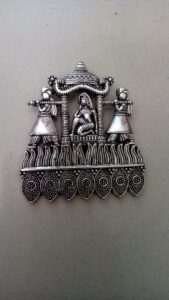
Step 1: Prepare a cleaning solution Fill a small bowl with warm water and add a few drops of mild dish soap or jewellery cleaner. Gently mix the solution to create a soapy mixture. If you don’t have jewellery cleaner, mild dish soap works just as well.
Step 2: Soak the jewellery Place your German silver jewellery in the cleaning solution and let it soak for about 5-10 minutes. This will help loosen any dirt or grime accumulated on the surface.
Step 3: Clean with a toothbrush or cloth Take a soft-bristled toothbrush or a clean, soft cloth and gently scrub the jewellery. Pay attention to intricate designs and hard-to-reach areas. Be careful not to apply too much pressure, as it may scratch the surface. Alternatively, you can use your fingers to rub the jewellery if a toothbrush is not available.
Step 4: Rinse and dry Once you’ve cleaned the jewellery, rinse it thoroughly under running water to remove any soap residue. Pat dry with a clean, lint-free cloth. Make sure the jewellery is completely dry before proceeding to the next step.
Step 5: Optional: Use lemon juice or vinegar If your German silver jewellery still appears tarnished, you can try using lemon juice or white vinegar. Dip a soft cloth or cotton ball in lemon juice or vinegar and gently rub the tarnished areas. Rinse with water and dry thoroughly.
Step 6: Polish and shine To give your German silver jewellery a final polish, use a soft, non-abrasive polishing cloth. Gently rub the surface of the jewellery in a back-and-forth motion to restore its shine. Avoid using harsh chemicals or abrasive materials, as they can damage the silver-like finish.
It’s important to note that German silver jewellery may tarnish again over time due to its composition. To help prevent tarnishing, store your jewellery in a clean, dry place, away from moisture and sunlight. Additionally, avoid exposing it to harsh chemicals, perfumes, or lotions.
By following these simple steps, you can keep your German silver jewellery looking beautiful and maintain its shine for years to come. Regular cleaning and proper care will ensure that your jewellery continues to dazzle and impress.
How to Make Silk Thread Bangles: A Step-by-Step Guide
Silk thread bangles are a beautiful and trendy accessory that can add a touch of elegance to any outfit. Creating your own silk thread bangles allows you to customize them to suit your style and preferences. In this step-by-step guide, we will walk you through the process of making silk thread bangles.
Materials you will need:
- Silk threads in your desired colors
- Bangles as a base
- Fabric glue or adhesive
- Decorative items like beads, stones, or charms
- Scissors
Step 1: Prepare the bangles Clean the bangles thoroughly to remove any dust or dirt. You can use a damp cloth or alcohol wipes to ensure they are clean and ready for decoration.
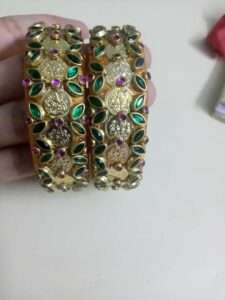
Step 2: Secure the silk thread Apply a small amount of fabric glue or adhesive at one end of the bangle. Place the end of the silk thread on the glue and press it firmly to secure it in place. This will be the starting point for wrapping the silk thread around the bangle.
Step 3: Wrap the silk thread Start wrapping the silk thread tightly around the bangle, making sure to cover the entire surface. Continue wrapping until you reach the desired thickness or until the bangle is fully covered. You can use a single color or experiment with multiple colors to create unique patterns or designs.
Step 4: Secure the end Once you have finished wrapping the silk thread, apply another small amount of fabric glue or adhesive to secure the end of the thread. Press it firmly to ensure it stays in place.
Step 5: Add embellishments (optional) To enhance the beauty of your silk thread bangles, you can add decorative items like beads, stones, or charms. Apply a small amount of glue to the desired location on the bangle and carefully attach the embellishments. Allow the glue to dry completely before wearing or handling the bangles.
Step 6: Repeat the process (optional) If you want to create a set of silk thread bangles, repeat the above steps for each bangle, using different colors or designs to create a coordinated set.
Once your silk thread bangles are complete, allow them to dry completely before wearing or storing them. These bangles can be a wonderful addition to your jewelry collection or a thoughtful handmade gift for someone special. So, grab your materials, unleash your creativity, and enjoy the process of making beautiful silk thread bangles!
Silk Thread Jewelry: Unleashing Elegance and Creativity
Silk thread jewelry has gained immense popularity in recent years due to its unique charm and versatility. This exquisite form of jewelry is made using silk threads, beads, and other embellishments, resulting in stunning pieces that can effortlessly enhance any outfit. Whether you’re looking to make your own silk thread jewelry or simply appreciate its beauty, this article will take you through the fascinating world of silk thread jewelry.
Silk thread jewelry offers a wide range of possibilities when it comes to designs and styles. From delicate earrings and necklaces to statement bangles and anklets, the options are endless. The softness and flexibility of silk threads allow for intricate weaving and knotting techniques, enabling the creation of intricate patterns and designs.
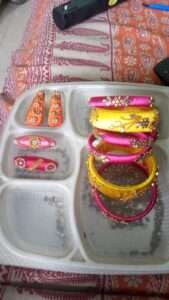
To create your own silk thread jewelry, you will need silk threads in various colors, beads, charms, and findings like hooks and clasps. The process involves wrapping the silk thread tightly around a base material, such as a bangle or pendant, and securing it with knots. Beads and other embellishments can be added to enhance the beauty and appeal of the piece.
One of the advantages of silk thread jewelry is its lightweight nature, making it comfortable to wear for long periods. It also offers a vast color palette, allowing you to match your jewelry to different outfits and occasions. Whether you prefer vibrant and bold colors or subtle and pastel hues, silk thread jewelry can be customized to suit your personal style.
In addition to being a fashion statement, silk thread jewelry also carries cultural significance. It is widely used in traditional Indian and South Asian jewelry, where it is often adorned with intricate designs and embellishments. Silk thread jewelry is not only an expression of creativity but also a celebration of cultural heritage.
Whether you’re creating silk thread jewelry for yourself or as a thoughtful gift for someone special, this art form offers endless possibilities for creativity and self-expression. With its delicate beauty and unique charm, silk thread jewelry is sure to captivate the hearts of jewelry enthusiasts worldwide. So, why not explore the world of silk thread jewelry and unlock your creativity today?
Exploring Essential Jewelry Making Findings
Jewelry making is a delightful craft that allows artisans to unleash their creativity and create unique pieces that reflect their personal style. Behind every stunning jewelry creation, there are a variety of jewelry making findings that play a crucial role in both aesthetics and functionality. These findings are the unsung heroes that provide structure, durability, and versatility to jewelry designs. Let’s dive into the world of jewelry making findings and explore their significance in the art of jewelry creation.
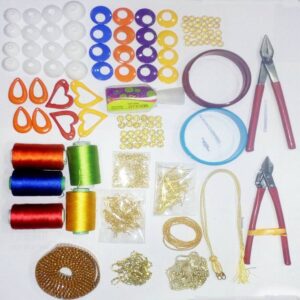
- Jump Rings: Jump rings are small metal rings with an opening that are used to connect various components of a piece together. They come in various sizes, metals, and finishes, allowing designers to choose the most suitable option for their designs. Jump rings are indispensable when it comes to attaching clasps, pendants, charms, and connecting chains.
- Lobster Clasps: Lobster clasps are one of the most popular types of clasps used in jewelry making. These spring-loaded clasps provide a secure and easy-to-use closure for necklaces, bracelets, and anklets. They come in different sizes and metals, allowing artisans to match them with the overall design and ensure a reliable fastening.
- Earwires: Earwires, also known as earring hooks or ear hooks, are essential findings for creating earrings. They provide a comfortable and secure way to attach earrings to the earlobe. Earwires come in various styles and materials, such as fishhook, leverback, or stud, enabling designers to customize their earring creations to suit different preferences and designs.
- Bead Caps: Bead caps are decorative findings that are placed on either end of a bead to add an extra touch of elegance and style. They come in different shapes, sizes, and designs, ranging from simple to intricate patterns. Bead caps not only enhance the overall aesthetics of a jewelry piece but also provide a professional finish by concealing the ends of the beads.
- Headpins and Eyepins: Headpins and eyepins are essential for creating dangles and drops in earrings, necklaces, and bracelets. These thin metal pins have a flat or looped end that securely holds beads, gemstones, or charms in place. They can be easily manipulated and trimmed to the desired length, making them versatile findings for various jewelry designs.
- Crimp Beads and Tubes: Crimp beads and tubes are essential for finishing off bracelets and necklaces made with beading wire. They are used to secure the ends of the wire and attach clasps or jump rings. By using crimping pliers, these small metal findings can be flattened or shaped to ensure a secure and professional-looking finish.
- Spacer Beads: Spacer beads are used to create spacing between larger beads, adding visual interest and balance to a jewelry design. They come in various shapes and sizes, including rondelle, saucer, and tube, and can be made of metals, glass, or gemstones. Spacer beads offer versatility and allow designers to create unique patterns and combinations.
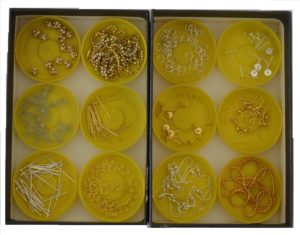
Jewelry making findings may seem like small components, but they play a vital role in the overall design, functionality, and durability of jewelry pieces. Whether you’re a novice jewelry maker or an experienced artisan, having a collection of these essential findings will empower you to explore endless design possibilities and bring your creative vision to life. So, next time you admire a beautiful piece of jewelry, take a moment to appreciate the intricate details and craftsmanship of the jewelry making findings that make it possible.
Tips for Handling Artificial Jewellery: Preserving Beauty and Durability
Artificial jewellery, also known as fashion or costume jewellery, offers a budget-friendly way to accessorize and enhance your style. While it may not be made of precious metals and gemstones, it still requires proper care and handling to preserve its beauty and longevity. Whether you’re wearing artificial jewellery on a daily basis or for special occasions, here are some essential tips to help you maintain and handle your pieces.
1. Store with Care: To prevent scratches and tangles, store your artificial jewellery in separate compartments or pouches. Avoid tossing them all together in a box, as this can cause damage and entanglement.
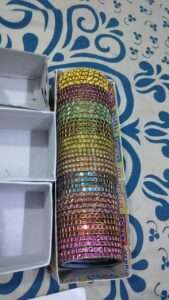
2. Keep Away from Moisture: Moisture can tarnish and damage artificial jewellery. Make sure to remove your pieces before swimming, showering, or engaging in water-related activities. Additionally, avoid storing them in damp areas like bathrooms.
3. Avoid Contact with Chemicals: Chemicals found in perfumes, lotions, and cleaning agents can harm the finish and color of your artificial jewellery. Apply beauty products before wearing your jewellery, and ensure it has dried completely before putting on your pieces.
4. Handle with Clean Hands: Dirt, oils, and sweat can accumulate on jewellery over time, diminishing its shine. Always handle your artificial jewellery with clean hands to maintain its luster and cleanliness.
5. Gentle Cleaning: Use a soft cloth or a mild jewelry cleaner specifically designed for artificial jewellery to gently remove any dirt or residue. Avoid harsh cleaning methods or abrasive materials that may scratch or damage the surface.
6. Take Precautions when Wearing: Artificial jewellery may not withstand rough handling or excessive bending. Be mindful when putting on or removing pieces, ensuring you don’t strain or pull at delicate components.
By following these simple tips, you can extend the life and beauty of your artificial jewellery collection. Remember that while artificial jewellery may not carry the same value as its precious counterparts, it can still hold sentimental and aesthetic worth. Treat your pieces with care, and they will continue to complement your style for years to come.
Cleaning Tarnished Jewelry with Home Remedies
Tarnish is a common issue that occurs when metals, such as silver or brass, react with air and moisture, resulting in a dull and discolored appearance. Fortunately, you can easily restore the shine and beauty of your tarnished jewelry using simple household items. Here’s a step-by-step guide on how to clean tarnished jewelry at home:
Materials you will need:
- Aluminum foil
- Baking soda
- Boiling water
- Soft cloth or toothbrush
- Mild dish soap
- Warm water
Step 1: Line a bowl with aluminum foil Take a bowl and line it with aluminum foil, shiny side up. The foil creates a chemical reaction that helps remove the tarnish from your jewelry.
Step 2: Place the tarnished jewelry on the foil Carefully place your tarnished jewelry on the aluminum foil, ensuring that each piece is in direct contact with the foil.
Step 3: Sprinkle baking soda over the jewelry Generously sprinkle baking soda over the tarnished jewelry, ensuring that it covers the entire surface. Baking soda acts as a gentle abrasive that helps remove tarnish without scratching the metal.
Step 4: Pour boiling water over the jewelry Slowly pour boiling water into the bowl, covering the jewelry completely. The hot water activates the cleaning process by dissolving the tarnish.
Step 5: Let it soak and fizz Allow the jewelry to soak in the solution for about 10-15 minutes. During this time, you may notice some fizzing or bubbling, which is a normal reaction as the tarnish is being lifted from the metal.
Step 6: Remove and rinse Carefully remove the jewelry from the bowl and rinse it under warm water. Gently rub the jewelry with a soft cloth or toothbrush to remove any remaining tarnish or residue.
Step 7: Clean intricate details For jewelry with intricate details or hard-to-reach areas, use a soft toothbrush dipped in a mixture of warm water and mild dish soap. Gently scrub the jewelry to remove any stubborn tarnish or dirt.
Step 8: Rinse and dry Thoroughly rinse the jewelry under warm water to remove any traces of baking soda or soap. Pat dry with a soft cloth and let it air dry completely before storing or wearing.
Additional Tips:
- Avoid using this method on jewelry with gemstones or pearls, as they may be damaged by the hot water or abrasive action of baking soda. Instead, consult a professional jeweler for cleaning options.
- Regularly store your jewelry in a dry and airtight container to prevent tarnish buildup.
- Use a jewelry polishing cloth or specialized jewelry cleaner for delicate or valuable pieces.
By following these simple steps and utilizing readily available household items, you can effectively clean tarnished jewelry and restore its original shine and beauty. Enjoy wearing your sparkling jewelry once again!
Return gift bangles and saree pins combo order for USA customer dispatched
Silk thread bangles and silk thread saree pins – 50 pairs of bangles and 50 saree pins have been made and dispatched to USA customer on order.
It took around 1 week to make the order and it was finally completed today.
Below is a glimpse of the order.
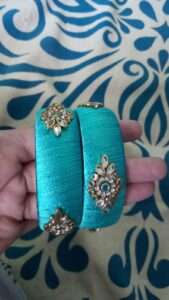
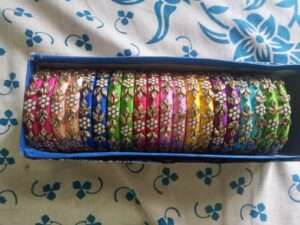
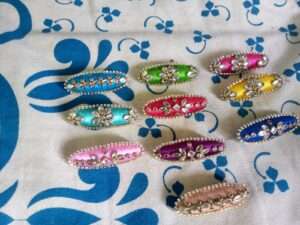
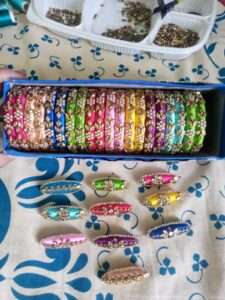
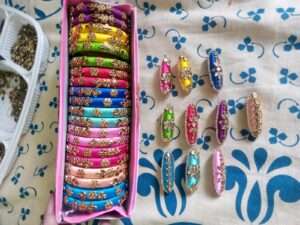
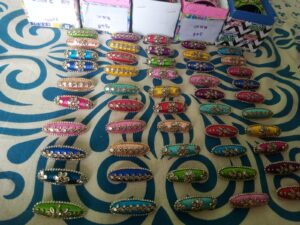
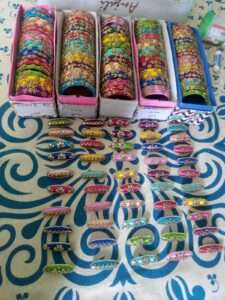
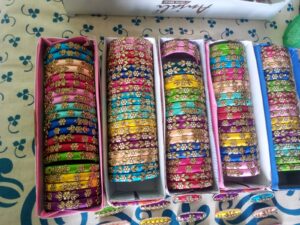
I selected 10 color threads, made 5 of each color, and did 2 pairs of 2 selected designs for a color.
The deal was very smooth as sufficient time was given.
I really got a good time as kid’s exams are going on and they got a holiday for each exam so that I could take care of their exams and focus on the order. My office work was also less comparatively so could complete the order in time.
If anyone want to place order, please contact me on whatsapp @ 7032378517, Let me know the details like quantity, size, colors designs etc and mainly give me sufficient time as I need to focus on personal front, kids studies, my job and business etc.
Recent order dispatched Silk thread bangles, saree pins, tic tac clips
A customer wanted a sample of silk thread jewelry items before they want to place a bulk order for return gifts. So they ordered silk thread bangles, saree pins, and tic tac clips.
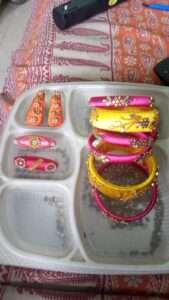
The order was completed the next day, packed, and kept within 3 hours. But there was a delay in pickup due to bad weather.
I am also dispatching many orders of raw materials but as I am focussing on my professional front, I am not getting time to post them here. Around 35-40 orders have been dispatched in 2023.
I restarted my career for a project in January, so focussing on that mainly. Whenever I am having time, I work on this business. That was a contract based and hoping to try for full-time as well. So as of now, I am working for office till May end, which may be extended depending on my luck.
And I am available almost all the time but won’t be able to take very very urgent orders.
Hoping for all the love and support from all of my beloved customers and friends.
